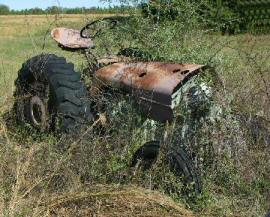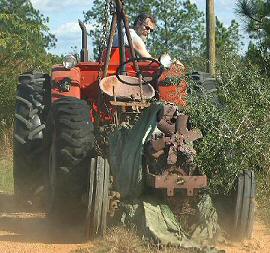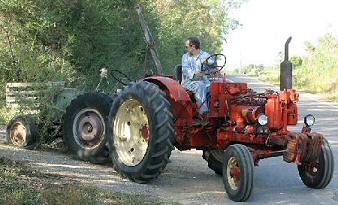
|

Case D industrial model, as found.
Big Red and Neal drag home the D. Yes, drag. The
brakes were locked.
Physically, the D isn't very big, but there is a lot
of iron in it.
Big Red could not lift it.

Yes,
we dragged it down a paved road.
No problem. The deal with the seller
was that he got to keep the tires. Heh, heh.
Big Red, got a workout
that day.
|
Assessment-- No good tires, 1 bent rim, engine half stuck,
trans stuck, no electrical system, crank broken, carb and part of
intake missing, manifold studs broken, 1 brake drum nut missing,
clutch full of oil, instruments missing, front rim bent. Someone
started a restoration and then sold it to someone else who let it
sit up. Many little parts are missing. The D series
had many variants and it will take a while to figure this thing
out as it had no serial number plate. Supposedly it was an
airplane hauler at an airport. |
|
|
Gallons of water and sludge floated
a layer of diesel to just the right level to protect the crank and
cam. Side covers on these old engines make access easy. |
|
|
The valve train was clean, but not properly adjusted, resulting in no compression on two cylinders. After spinning the engine a bit, oil began appearing on the rockers. That's a good sign. |
|
|
The mag would not fire and was full of ants. We chased out the ants and cleaned the points. The gold box is an aircraft mag timer. It beeps when the points open. Aeroplanes have two mags that have to be exactly synchronised, which you can't do with a light. This is a handy device available from any aircraft supply catalog. Cleaning the points did the trick. We still need to build a kill button. |
|
|
We prefer to think of the color as sunbleached primer from an old start at restoration. We've only seen one tractor that was intentionally painted pink. It just doesn't seem right. |
Update: The mag is firing, but we need a new battery bolt on the starter. We also need to get out some broken studs before we can mount the manifolds. We have acquired the shell of a carburetor and are looking for the internal parts. We've started a mag page, but we don't yet have photos. Still, the info might be useful to you. We learned from the previous owner that he had filled every hole with diesel. That makes us feel better about what we found in the clutch. A real bear is going to be those huge, stuck break drums. 11-14-04